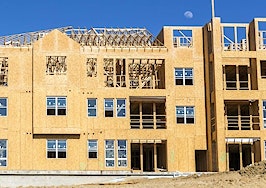- This month, the U.S. Census Bureau reported that new residential construction spending in May was at a seasonally adjusted annual rate of $451.9 billion.
- This is very close to the revised April 2016 estimate of $451.7 billion, and above the May 2015 estimate of $359.5 billion, showing signs of recent stagnation despite an overall upward trend year-over-year.
When real estate agents across the country gather to complain about the things making their lives difficult, one of the top gripes in 2016 has to be “inventory.” Where is the supply to meet buyer demand?
This month, the U.S. Census Bureau reported that new private residential construction spending in May was estimated at a seasonally adjusted annual rate of $451.9 billion.
This is very close to the revised April 2016 estimate of $451.7 billion, and above the May 2015 estimate of $359.5 billion, showing signs of recent stagnation despite an overall upward trend year-over-year.
Earlier this year, Inman columnist Lou Barnes noted that it takes awhile to “get the engine going” on new housing — “labor, land and materials” don’t just magically appear. However, we’re now seven years out from the recession’s end, and inventory growth remains stalled.
Spending on new single-family housing specifically was estimated at 239.2 billion in May, down 1.3 percent from 242.3 billion the previous month. However, this is up 6 percent from single-family spending a year prior (225.0 billion).
The Census Bureau’s construction spending estimates are based on the “Value of Construction Put In Place Survey,” which provides monthly estimates of the total dollar value of construction work done in the U.S.
[Tweet “Where is the supply to meet buyer demand?”]
The survey includes construction done each month on new structures and improvements to existing structures for both the private and public sectors; these numbers are private residential construction estimates.
The estimates include the cost of:
- Labor
- Materials
- Architectural work
- Engineering work
- Overhead costs
- Interest paid during construction
- Taxes paid during construction
- Contractors’ profits
According to the Census Bureau, “data collection and estimation activities begin on the first day after the reference month and continue for about three weeks. Reported data and estimates are for activity taking place during the previous calendar month.”
The survey has been conducted every month since 1964, and you can see press releases summarizing the results since 2003.







